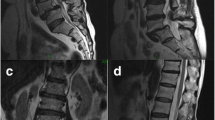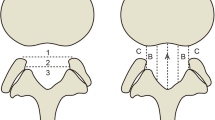Abstract
Background
Magnetic resonance imaging (MRI) is important in the assessment of degenerative spine disease. However, its role is limited in the identification of spinal instability; therefore, weight-bearing and dynamic studies like X-rays are required. The supine position eliminates the gravitational pull, corrects the vertebral slippage, and opens the facet joints leading to the collection of the synovial fluid into the joint space, which is detected on the MRI and can serve as a marker for instability. We aim to compare the facet fluid, facet hypertrophy, facet angle, and disc degenerative changes among the patients presenting with degenerative spondylolisthesis (DS) and those without.
Methods
We performed a retrospective review for all the patients treated at our institution from January 2015 to December 2016. Facet Fluid Index (FFI) (ratio of facet fluid width and facet joint width) was calculated to assess the joint fluid. The percentage of spondylolisthesis was measured on X-rays. Each radiological parameter was compared between the two groups, i.e., patients with DS and patients without DS. A p value < 0.05 was considered significant.
Results
In total, 61 patients, 28 with DS and 33 without DS, were enrolled. Baseline characteristics were similar in the two groups (p > 0.05). The average values of FFI, facet fluid width, and the difference between the superior and inferior facet were significantly higher in the group with instability (p < 0.05). Multivariate analysis demonstrated a 4.44 (95% confidence interval [CI] 2.03–5.365) times increase in the odds of instability with a unit increase in FFI, p < 0.0001.
Conclusions
We report a positive linear correlation between the facet joint effusion and facet hypertrophy on MRI and the percentage of vertebral translation on X-ray. Prospective studies will determine if these markers can play a role in predicting spinal instability.





Similar content being viewed by others
Abbreviations
- AUC:
-
area under the curve
- CI:
-
confidence interval
- DS:
-
degenerative spondylolisthesis
- DSD:
-
degenerative spine disease
- FFI:
-
facet fluid index
- IQR:
-
inter-quartile range
- JOA:
-
Japanese orthopedic association
- MRI:
-
magnetic resonance imaging
- NPV:
-
negative predictive value
- ROC:
-
receiver operating characteristic
- SD:
-
standard deviation
References
Rihn JA, Lee JY, Khan M, Ulibarri JA, Tannoury C, Donaldson WF III, Kang JD (2007) Does lumbar facet fluid detected on magnetic resonance imaging correlate with radiographic instability in patients with degenerative lumbar disease? Spine 32(14):1555–1560
Bendo J, Ong B (2001) Importance of correlating static and dynamic imaging studies in diagnosing degenerative lumbar spondylolisthesis. Am J Orthop (Belle Mead, NJ) 30(3):247–250
Cho BY, Murovic JA, Park J (2009) Imaging correlation of the degree of degenerative L4–5 spondylolisthesis with the corresponding amount of facet fluid. J Neurosurg Spine 11(5):614–619
Wood KB, Popp CA, Transfeldt EE, Geissele AE (1994) Radiographic evaluation of instability in spondylolisthesis. Spine 19(15):1697–1703
Mailleux P, Ghosez J, Bosschaert P, Malbecq S, Coulier B (1998) Distension of the inter-facet joints in MRI: and indirect sign of an existing underestimation of spondylolisthesis and canal stenosis. J Belg Radiol 81(6):283–285
Caterini R, Mancini F, Bisicchia S, Maglione P, Farsetti P (2011) The correlation between exaggerated fluid in lumbar facet joints and degenerative spondylolisthesis: prospective study of 52 patients. J Orthop Traumatol 12(2):87–91
Chaput C, Padon D, Rush J, Lenehan E, Rahm M (2007) The significance of increased fluid signal on magnetic resonance imaging in lumbar facets in relationship to degenerative spondylolisthesis. Spine 32(17):1883–1887
Cho IY, Park SY, Park JH, Suh SW, Lee SH (2017) MRI findings of lumbar spine instability in degenerative spondylolisthesis. J Orthop Surg 25(2):2309499017718907
Hasegawa K, Kitahara K, Shimoda H, Hara T (2010) Facet joint opening in lumbar degenerative diseases indicating segmental instability. J Neurosurg Spine 12(6):687–693
Hipp JA, Guyer RD, Zigler JE, Ohnmeiss DD, Wharton ND (2015) Development of a novel radiographic measure of lumbar instability and validation using the facet fluid sign. International journal of spine surgery 9:
Lattig F, Fekete TF, Grob D, Kleinstück FS, Jeszenszky D, Mannion AF (2012) Lumbar facet joint effusion in MRI: a sign of instability in degenerative spondylolisthesis? Eur Spine J 21(2):276–281
Schinnerer KA, Katz LD, Grauer JN (2008) MR findings of exaggerated fluid in facet joints predicts instability. Clin Spine Surg 21(7):468–472
Berlemann U, Jeszenszky D, Bühler D, Harms J (1998) Facet joint remodeling in degenerative spondylolisthesis: an investigation of joint orientation and tropism. Eur Spine J 7(5):376–380
Samartzis D, Cheung JPY, Rajasekaran S, Kawaguchi Y, Acharya S, Kawakami M, Satoh S, Chen W-J, Park C-K, Lee C-S (2016) Critical values of facet joint angulation and tropism in the development of lumbar degenerative spondylolisthesis: an international, large-scale multicenter study by the AOSpine Asia Pacific Research Collaboration Consortium. Global Spine J 6(5):414–421
Williams R, Cheung JPY, Goss B, Rajasekaran S, Kawaguchi Y, Acharya S, Kawakami M, Satoh S, Chen W-J, Park C-K (2016) An international multicenter study assessing the role of ethnicity on variation of lumbar facet joint orientation and the occurrence of degenerative spondylolisthesis in Asia Pacific: a study from the AOSpine Asia Pacific Research Collaboration Consortium. Global Spine J 6(1):35–45
Meyerding HW (1932) Spondyloptosis. Surg Gynecol Obstet 54:371–377
Chaput CD, Allred JJ, Pandorf JJ, Song J, Rahm MD (2013) The significance of facet joint cross-sectional area on magnetic resonance imaging in relationship to cervical degenerative spondylolisthesis. Spine J 13(8):856–861
Issack PS, Cunningham ME, Pumberger M, Hughes AP, Cammisa FP Jr (2012) Degenerative lumbar spinal stenosis: evaluation and management. J Am Acad Orthop Surg 20(8):527–535
Splendiani A, Patriarca L, Mariani S, Cesare E, Gallucci M (2015) Lumbar spinal instability: an updated review. OMICS J Radiol 4(178):2
Snoddy MC, Sielatycki JA, Sivaganesan A, Engstrom SM, McGirt MJ, Devin CJ (2016) Can facet joint fluid on MRI and dynamic instability be a predictor of improvement in back pain following lumbar fusion for degenerative spondylolisthesis? Eur Spine J 25(8):2408–2415
Ben-Galim P, Reitman CA (2007) The distended facet sign: an indicator of position-dependent spinal stenosis and degenerative spondylolisthesis. Spine J 7(2):245–248
Ko S, Chae S, Choi W, Kim J-Y, Kwon J, Doh J (2019) The prevalence of facet tropism and its correlation with low back pain in selected community-based populations. Clin Orthop Surg 11(2):176–182
Wang J, Yang X (2009) Age-related changes in the orientation of lumbar facet joints. Spine 34(17):E596–E598
Lattig F, Fekete TF, Kleinstück FS, Porchet F, Jeszenszky D, Mannion AF (2015) Lumbar facet joint effusion on MRI as a sign of unstable degenerative spondylolisthesis: should it influence the treatment decision? Clin Spine Surg 28(3):95–100
Acknowledgments
The authors thank Wardah Khalid for the statistical advice.
Author information
Authors and Affiliations
Corresponding author
Ethics declarations
Conflict of interest
The authors declare that they have no conflict of interest.
Details of previous presentation(s)
Part of the content of this paper was presented at the European Association of Neurosurgical Societies 2019 Congress, September 27, 2019; Dublin Ireland, oral presentation; and the 2020 American Association of Neurological Surgeons Annual Scientific Meeting, May 2020, E-poster.
Ethical approval
All procedures performed in studies involving human participants were in accordance with the ethical standards of the institutional and/or national research committee and with the 1964 Helsinki declaration and its later amendments or comparable ethical standards. “For this type of study formal consent is not required.”
Additional information
Publisher’s note
Springer Nature remains neutral with regard to jurisdictional claims in published maps and institutional affiliations.
This article is part of the Topical Collection on Spine degenerative
Rights and permissions
About this article
Cite this article
Naeem, K., Nathani, K.R., Barakzai, M.D. et al. Modifications in lumbar facet joint are associated with spondylolisthesis in the degenerative spine diseases: a comparative analysis. Acta Neurochir 163, 863–871 (2021). https://doi.org/10.1007/s00701-020-04657-3
Received:
Accepted:
Published:
Issue Date:
DOI: https://doi.org/10.1007/s00701-020-04657-3




